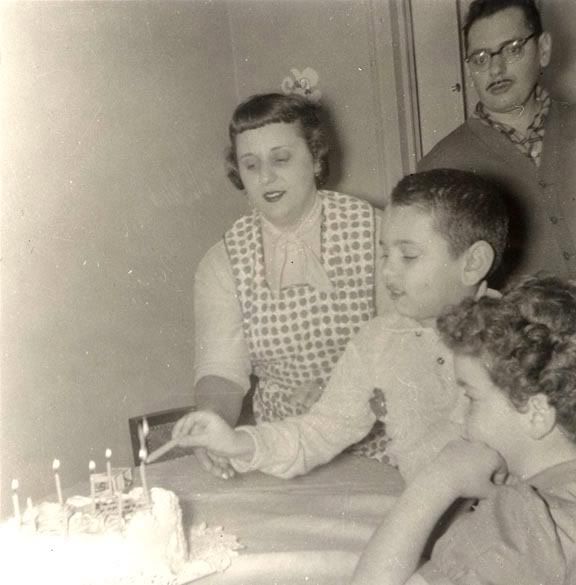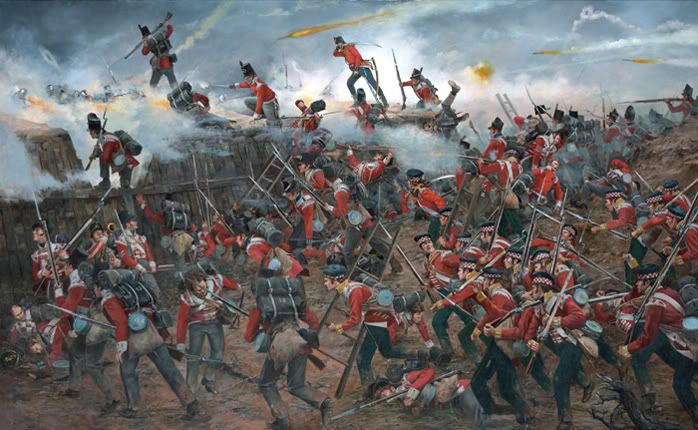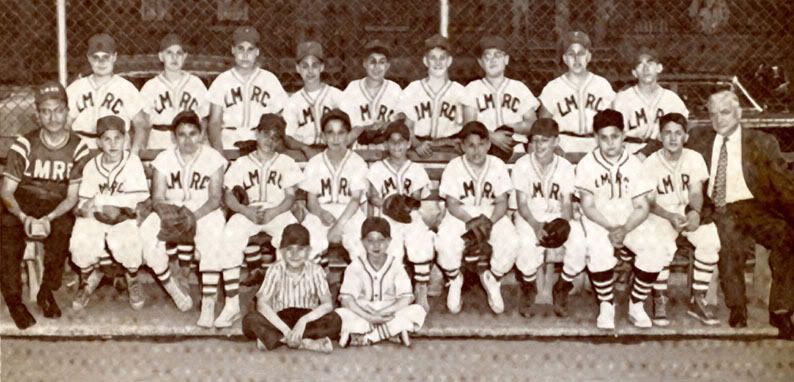
My wife found an album of family pictures that I rescued from my parent's house that had long been missing. From January 8th, 1955. Is that Julius Rosenberg's brother in the background?

On this day, January 8, 1815, outnumbered three-to-one by British regulars commanded by Major General Sir Pakenham (brother-in-law to the Duke of Wellington), Irish-American Andrew Jackson led a motley crew of Americans to one of the most decisive and stunning victories in military history. At the end of the day, Pakenham and his top three subordinate generals lay dead along with more than 2,000 British troops killed, wounded or captured. American casualties were eight killed and 34 wounded.
In the words of Jackson scholar Robert Remini (who used to teach at Fordham), the battle settled once and for all "the enduring ability of a free people to protect and preserve their society and way of life". From Daniel Haston on Jackson's army
"Never has a more polyglot army fought under the Stars and Stripes than did Jackson's force at the Battle of New Orleans. In addition to his regular U.S. Army units, Jackson counted on dandy New Orleans militia, a sizable contingent of black former Haitian slaves fighting as free men of color, Kentucky and Tennessee frontiersmen armed with deadly long rifles and a colorful band of outlaws led by Jean Lafitte, whose men Jackson had once disdained as "hellish banditti." This hodgepodge of 4,000 soldiers, crammed behind narrow fortifications, faced more than twice their number."

A NATION'S GRATITUDE?
Designer of Our Present Flag in Unmarked Grave for 95 Years
by C. W. Tazewell - 1967
Louisana and the Northwest Territory might now be British if Reid had not engaged them in what has been called one of the world's most decisive naval battles.
Thomas Manning, an amateur historian, knew the story of Captain Samuel Chester Reid, designer of our present flag. Manning had reason to believe that he might be buried at Green-Wood Cemetery, Brooklyn, N. Y. As cemetery supervisor he had ready access to the old, faded records. His search was rewarded with success, and he discovered the unmarked grave where the naval hero of the war of 1812 and Congressional Medal of Honor winner had remained unknown and unrecognized for almost 95
years. Further investigation verified that the Reid buried there was the naval hero. Manning obtained the support of Brooklyn Congressman Francis E. Dorn, local veteran's groups and other organizations to properly mark Reid's last resting place. The greatest difficulty was in locating the surviving descendants to receive permissions for the monument.
The Old Glory Post No. 48 of the American Legion responded by marking the grave with a flag and wreath until the erection of the monument, according to David Terada, now resident of Norfolk. Terada was then Commander of the Brooklyn Post and is now Americanism Chairman of Norfolk's American Legion Post No. 60. On October 28, 1956, the efforts of the Reid Memorial Committee met with fruition. Having been authorized by Act of Congress a granite monument and flag pole were dedicated during colorful ceremonies. Secretary of the Navy Charles S. Thomas gave the principal address and Terada laid a wreath for Kings County veterans organizations. The ceremonies were attended by two of Reid's descendants, Col. Louis Sanders, a great-grandson, and Samuel Chester Reid, 4th, a great-great-grandson.
Capt. Reid designed the third version of the Stars and Stripes in 1818 at the request of a Congressional Committee headed by Peter H. Wendover, Representative from New York City. The original flag of the United States of America was created by Resolution of Congress on June 14, 1777, with thirteen stars and stripes. The second Flag Act was passed in 1794 to authorize fifteeen stars and fifteen stripes due to entry of Vermont and Kentucky into the Union. By 1818 there were twenty states and entry of others was expected soon. It was impractical to continue to add stripes as more and more states were admitted. So, Wendover's committee adopted Reid's proposal that the stripes be fixed at thirteen with one star for each state. On acceptance of the design by Congress, Mrs. Reid made the first new flag with silk provided by the government. It was flown from the Capitol dome on April 13, 1818. The twenty stars were formed in "one great luminary" as a large composite star. Notwithstanding the later establishment by President Monore of the arrangement of stars in equal rows, they were non-uniform in many flags. As late in 1857 stars were seen in the form of large stars, as a lozenge, diamond or circle, and even as an anchor.
Samuel Chester Reid was born in 1783, son of John Reid, a Scottish lieutenant in the Royal Navy. His father was captured in an expedition against New London, Conn., in 1780, and was paroled in the custody of Judge Chester of Norwich. He married the judge's daughter, Rebecca. The son became a powder monkey in the U. S. Navy as a boy and served under Commodore Truxton as a midshipman. In the War of 1812 he was made captain of the privateer, GENERAL ARMSTRONG. His ship was pursued by a British squadron when he left New York in September, 1814. Through his skill he escaped during light winds by pumping water on the sails and by towing by rowers in the ship's boats. On the afternoon of September 26 he entered the harbor at Fayal in the Azores. A squadron of three British ships arrived soon afterwards, with 136 guns and 2,000 men. The GENERAL ARMSTRONG had seven small guns and 90 men. In the evening the British attacked with four smaller boats and were beaten off. Later, at midnight, fourteen boats with cannonades and 600 men attacked the Americans again. The British succeeded in boarding the GENERAL ARMSTRONG after heavy losses from cannon fire. In hand-to-hand combat with the courageous crew the British were repelled with many dead and wounded. Reid dueled and killed the British leader with his cutlass. Reid moved all of his guns to one side of his ship by cutting new gun ports during the night in anticipation of further attacks. With the light of dawn the 18-gun CARNATION came in and received a withering fire from the ARMSTRONG, taking so much punishment that she left the battle. As the larger British ship PLANTAGENET with 74 guns began moving in for the kill, Reid scuttled his ship.
On the next day Captain Reid was invited to tea with the surviving British officers at the British Consulate. Notwithstanding the objections of the American consul, Reid accepted, ignoring the possibility of a trap. He was cheered and welcomed by the British officers as a brave and resourceful foe. General Andrew Jackson later told Capt. Reid that "If there had been no Battle of Fayal, there would have been no Battle of New Orleans." Reid had delayed the British expedition against New Orleans for ten days allowing Jackson to arrive there earlier. Thus, Louisiana and the Northwest Territory might now be British if Reid had not engaged them in what has been called one of the world's most decisive naval battles. Capt. Reid received many honors and was a popular naval hero. The Thanks of Congress and the Medal of Honor were awarded to him along with a gold sword from the State of New York and a silver tea service from the City of New York. The sword is in the Metropolitan Museum and the tea service is in the Museum of the City of New York.
After the War of 1812 Samuel Chester Reid became harbor master for New York City. He made many innovations including a signal code for U. S. vessels and the use of the semaphore system for speedy advice on ship arrivals. He devised a method of rapid signaling by land which permitted messages to go from New York to New Orleans in two hours. Having served his country well in peace and war, Capt. Reid died in 1861 at the age of 78. He is due the gratitude of the Nation, and our recognition on Flag Day as the designer of our present flag. His grave is now a symbol of our patriotism and dedication.
Postscript -
A descendant of Samuel Chester Reid, Mrs. Elizabeth Virginia Johnson, was living in Portsmouth, Va. in 1967. It was noted in _The Virginian-Pilot_ of Feb. 26, 1967, that Mrs. Johnson's mother's oldest brother, W. B. Reid, married a direct descendant of Betsy Ross. This Mrs. Reid made a Confederate flag to be flown during the Civil War atop a paper mill at Neuse River Falls, N. C.
In eighteen-fourteen we took a little trip
Along with Colonel Jackson down the mighty Mississipp'
We took a little bacon and we took a little beans
And we caught the bloody British in the town of New Orleans
We fired our guns and the British kept a comin'
There wasn't nigh as many as there was a while ago
We fired once more and they began to runnin'
On down the Mississippi to the Gulf of Mexico
We looked down the river and we seed the British come
And there must've been a hundred of 'em beatin' on the drum
They stepped so high and they made their bugles ring
We stood beside our cotton bales, didn't say a thing
We fired . . .
Old Hickory said we could take 'em by surprise
If we didn't fire muskets till we looked 'em in the eye
We held our fire till we seed their faces well
Then we opened up our squirrel guns and really gave 'em well
We fired . . .
Yeah they ran through the briars and they ran through the brambles
And they ran through the bushes where a rabbit couldn't go
They ran so fast that the hounds couldn't catch 'em
On down the Mississippi to the Gulf of Mexico
We fired our cannon till the barrel melted down
So we grabbed an alligator and we fought another round
We filled his head with cannonballs and powdered his behind
And when we touched the powder off the 'gator lost his mind
We fired . . .
They ran . . .
"The Battle of New Orleans" is the name of a song written by Jimmie Driftwood. The song details the 1815 Battle of New Orleans from the perspective of an American fighting alongside Andrew Jackson against British forces, but the tone is lighthearted. It has been recorded by many artists, but the one most often associated with this song is Johnny Horton. His version topped the Billboard Hot 100 in 1959 (see 1959 in music).
In Billboard magazine's rankings of the top songs in the first fifty years of the Billboard Hot 100 chart, "The Battle of New Orleans" was ranked as the twenty-eighth song overall and the number-one country song to appear on the chart.[2]
The melody has its roots in a well-known American fiddle tune "The 8th of January", which was the date of the Battle of New Orleans. Jimmie Driftwood, a school principal in Arkansas with a passion for history, set a historical account of the battle to this music in an attempt to get students interested in learning history. It worked, and Driftwood became well known in the region for his historical songs. He was "discovered" in the late 1950s by Don Warden, and eventually signed to a recording contract by RCA, for whom he recorded 12 songs in 1958, including "The Battle of New Orleans".
"The Battle of New Orleans" is often played during North American sporting events, and is commonly heard during home games of the NHL's Calgary Flames.
Other versions
As noted, Johnny Horton's 1959 version is the best-known recording of the song. Horton also recorded an alternative version for release in British Commonwealth countries which had more favourable lyrics toward the British. The word "British" was replaced with "Rebels" along with a few other differences.
Many other artists have recorded this song. Notable versions include the following:
* In the United States, Vaughn Monroe's 1959 single competed with Horton's but did not achieve the same degree of success and became only a minor Hot 100 hit.
* In the United Kingdom, Lonnie Donegan and His Skiffle Group's 1959 version competed with Horton's and achieved greater success, peaking at number two. In Donegan's spoken introduction, he made it clear that the British were on the losing side.
* Harpers Bizarre had a minor Hot 100 hit with their somewhat psychedelic version from their 1968 album Secret Life of Harpers Bizarre.
* Johnny Cash covered the song in 1972 on the album America: A 200-Year Salute in Story and Song.
* The Germany-based Les Humphries Singers 1972 hit, "Mexico", used the melody and parts of the lyrics, violating copyright by crediting the song to British bandleader Les Humphries.
* Nitty Gritty Dirt Band had a minor Hot 100 hit with their version in 1974.
* Commander Cody and his Lost Planet Airmen played a cover of the song at their performance in New York, NY, on September 14, 1976.[3]
* Bill Haley recorded a version in 1979 at his final recording sessions and it was released on his final album, Everyone Can Rock and Roll.
* Perhaps the most unexpected recording is The Mormon Tabernacle Choir's 1991 cover on their album Songs from America's Heartland.
Country parodists Homer and Jethro had a hit when they parodied "The Battle of New Orleans" with their song "The Battle of Kookamonga." The single was released in 1959 and featured production work by Chet Atkins. In this version, the scene shifts from a battleground to a campground, with the combat being changed to the Boy Scouts chasing after the Girl Scouts.











